China’s national railway fixed-asset investment reached 410.2 billion yuan (approximately 57.21 billion U.S. dollars) from January to July 2024, marking a year-on-year growth of 10.5 percent, according to the China State Railway Group.
In July, key railway construction projects continued to make steady progress. The Rizhao-Lankao High-Speed Railway was fully completed and put into operation, significantly reducing travel time between Shandong and the Central Plains urban agglomerations.
Several railway projects, including the Xuancheng-Jixi High-Speed Railway, the Huinong-Yinchuan section of the Baotou-Yinchuan High-Speed Railway, and the Zhenjiangguan-Huangshengguan section of the Chengdu-Xining Railway, began joint testing and commissioning in July.
Hangzhou-Wenzhou High-Speed Railway started trial operations in July.
“China State Railway Group will focus on enhancing railway network connectivity. We will accelerate the construction of major projects such as the Chongqing-Kunming High-Speed Railway, the Shanghai-Chongqing-Chengdu Riverside High-Speed Railway, and the Huangtong-Baise Railway. These efforts aim to continuously improve the interconnectivity of railway infrastructure, providing strong support for the high-quality development of the national economy and society,” said Deng Lihong, deputy director of the Development Strategy and Planning Division of the group.
China’s railway fixed-asset investment reaches 410 bln yuan from January to July
Since the beginning of 2024, China has seen its prudent monetary policy prop up economic growth, with money and credit supplies maintaining reasonable growth, according to the second-quarter monetary policy execution report released by the People’s Bank of China (PBoC) on Friday.
The country has promoted a stable and moderate reduction in the overall cost of social financing.
In January, the central bank lowered the re-lending and rediscounting rates for agricultural and small enterprises by 0.25 percentage points. In July, it reduced the seven-day reverse repo rate in the open market by 0.1 percentage points, continuing to promote the marketization of deposit interest rates and guide the downward trend of market interest rates, including the loan prime rate (LPR).
China has also intensified efforts to guide the adjustment and optimization of the credit structure. The central bank has allocated 500 billion yuan (approximately 69.73 billion U.S. dollars) to support re-lending for sci-tech innovation and technological transformation and 300 billion yuan (approximately 41.84 billion U.S. dollars) for government-subsidized housing.
It has loosened identification standards for inclusive loans to micro and small businesses, expanded support for carbon emissions reduction tools, and implemented various existing monetary policy measures.
Meanwhile, the central bank has introduced several real estate-supportive measures: lowering the minimum down payment ratio for personal housing loans, removing the lower limit on interest rates for these loans, and reducing the interest rate for housing provident fund loans.
Exchange rate stability has been achieved. The PBoC has prioritized the market’s decisive role in exchange rate formation, fully utilized the exchange rate’s regulatory function on the macroeconomy and balance of payments, maintained exchange rate flexibility, strengthened market expectations guidance, and taken firm measures to prevent the risk of exchange rate overshooting.
Risk prevention and mitigation have been reinforced through enhanced financial risk monitoring and assessment, careful risk management in key regions and institutions, and strengthened systems to safeguard financial stability.
Overall, monetary policy has been supportive since the beginning of the year, providing financial backing for sustained economic recovery and growth.
Prudent monetary policy fuels economic recovery in China: report









